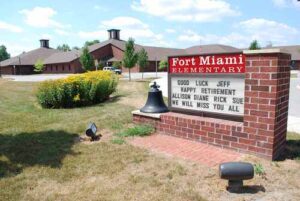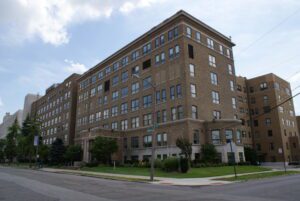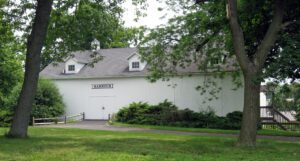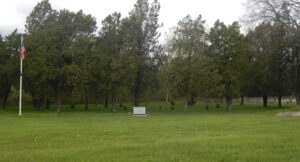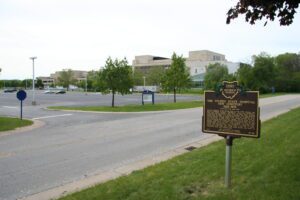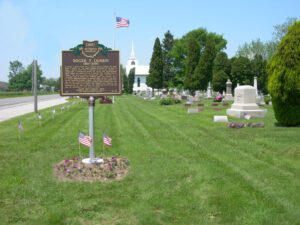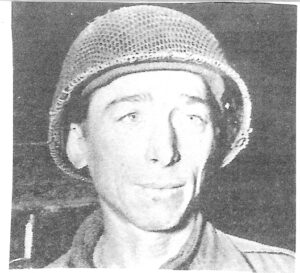, OH
For nearly a century, this 98-acre site was occupied by an orphanage that, over the years, cared for several thousand destitute children. Founded in nearby Toledo in 1867 as the Protestant Orphan’s Home, the orphanage became the Lucas County Children’s Home shortly after it was relocated to this former farmland in 1887. It was renamed the Miami Children’s Center in 1960 before closing permanently in 1986. The main campus, across the River Road, was sold for residential use. The playground, on this side of the road, originally connected to the main campus by a tunnel, was given to the Maumee school system in 2004 as the site for the current Ft. Miami Elementary School. On these grounds, the laughter of a new generation of children at play is being heard once more….a fitting tribute to the disadvantaged boys and girls who formerly lived here.
, OH
In late 1911, the Right Reverend Joseph Schrembs, Toledo’s first Bishop, corresponded with Sister Mary Bernardine McMullen and two companions, Sister Mary Anthony McMullen and Sister Mary DeChantel Lyons, and asked them to come to Toledo to establish the second of three Catholic hospitals in the new diocese. Land was purchased in 1916 on the corner of Madison Avenue and 23rd Street to build what would become a seven-story hospital. Noted Chicago architect, Meyer J. Sturm, was hired to design and construct the hospital using up-to-date methods of hospital construction. Costing approximately $300,000, Mercy Hospital of Toledo was completed in 1918. Bishop Schrembs dedicated and blessed the hospital on June 21 in a grand ceremony involving clergy of the diocese and the Mercy Hospital Guild as guests of honor.
, OH
Sylvania was once the headquarters for the Toledo and Western Railway, an electric interurban line that provided service between Toledo and Pioneer with a branch line to Adrian, Michigan. Construction began here in 1900 with planning and specifications set to steam railroad standards. With completion of rails, a powerhouse, maintenance facilities, and offices, the Toledo and Western Railway Company was soon in the business of providing freight and passenger service and was especially competitive as it owned more freight engines than most interurban lines. Operating an electric interurban line also meant that the company had the ability to provide electricity to people living in Sylvania and to other communities and property owners living along the line’s right-of-way. Besides freight, passengers, and electricity, Toledo and Western also provided postal service, one of the first interurban lines to do so. [continued on other side]
, OH
The David and Clarissa Harroun family migrated to Sylvania in 1835 and built their home, and in 1858 the barn, on this site. Four generations of this Harroun family called this property home, from 1835-1938. While here, David, Clarissa, and their son Edwin became involved in aiding fugitive slaves across the Underground Railroad to freedom in Canada. David secretly transported the runaways from Maumee to Sylvania in his lumber wagons. The fugitives were covered in hay, and the wagons were driven at night to avoid detection. Once on Harroun’s property, they were hidden in the attic of the home or the hayloft of the barn. The Lathrop family, who lived on a farm to the west, helped the Harrouns by hiding fugitives in the basement of their home. From Sylvania, the runaways were taken to Bedford, Petersburg, or Monroe in Michigan where they were then transported toward Detroit for their crossing into Canada.
, OH
Toledo State Hospital opened in January 1888 as the Toledo Asylum for the Insane. Originally located immediately south of this cemetery, the hospital was designed to function as a self-contained community for 650 people. Patients lived in large cottages, surrounded by a post office, church, library, male and female hospital, strong wards, bakery, and dining hall. People were admitted with mild to severe forms of mental illness, and a variety of other disabling conditions, including developmental, medical or neurological, as well as for addictions, injuries, and old age. Work became a form of treatment, with patients involved in construction, farming, laundry, and other jobs to help maintain the hospital. Patients could also participate in recreational activities from gardening to playing in the hospital band. The State Hospital became home for many, as hospitalization could last a lifetime, often spanning decades. (continued on other side)
, OH
Toledo State Hospital opened in January 1888 as the Toledo Asylum for the Insane. People were admitted with mild to severe forms of mental illness, and a variety of developmental, medical and neurological conditions, as well as for addictions, injuries, and old age. Originally built to house 650 people, by the 1950s its campus had grown to accommodate over 3,000. Growing access to new medications and treatments then began a gradual decline in patient population. Eventually, most of the buildings were razed, and much of the hospital’s property was transferred, later becoming the site of The Medical College of Ohio. This transfer included the two Toledo State Hospital cemeteries, with documented burials (as of 2009) totaling 1,994 persons. Toledo State Hospital New Cemetery was opened in 1922, when the Old Cemetery (1888-1922), located .5 miles to the northeast, reached capacity. (continued on other side)
, OH
According to fellow World War II veteran and U.S. Senator Bob Dole, Roger T. Durbin was “the public persona—the beacon—of the drive to build a National World War II Memorial in our nation’s capital.” It started with a conversation between Mr. Durbin and Congresswoman Marcy Kaptur at a local fish fry in February 1987. Enlisting Kaptur’s support, the work to create the memorial began. Described as a “gentleman with a square jaw, twinkling eyes, and churlish grin,” Mr. Durbin committed himself to serving others. He was a rural letter carrier, Richfield Township trustee, and coached Little League baseball. He was a veteran of the Tenth Armored (Tiger) Division and saw action at the Battle of the Bulge. The National WWII Memorial was dedicated May 29, 2004. Although Mr. Durbin did not live to see that day, his determination is the reason it stands.
, OH
Alexander Albert Drabik was born here, in a log cabin, on December 28, 1910 to John Drabik and Frances Lewandowski, Polish immigrants from Szymborze, Germany, now Poland. Alex, youngest son of 14 children, attended Door Street School. A meat cutter, he enlisted in the United States Army in October 1942. Drabik fought in the Ardennes, Central Europe and Rhineland Campaigns of World War II. He received a Purple Heart during the Battle of the Bulge. On March 7, 1945, Sergeant Drabik led 10 Company A soldiers of the 27th Armored Infantry Battalion of the 9th Armored Division across the Ludendorff railroad bridge from Remagen, Germany to the Rhine River east bank. (Continued on other side)


